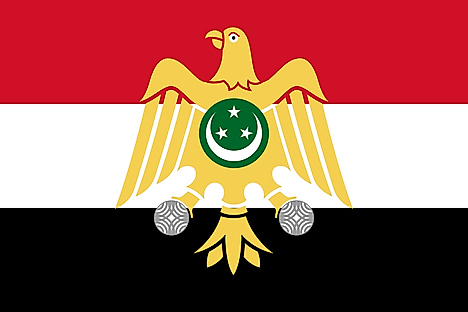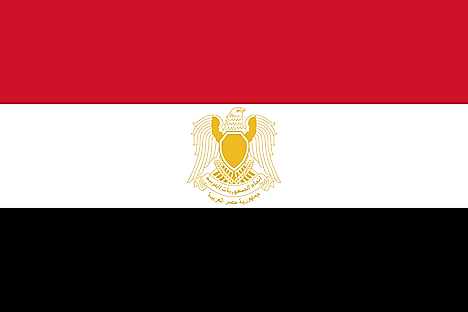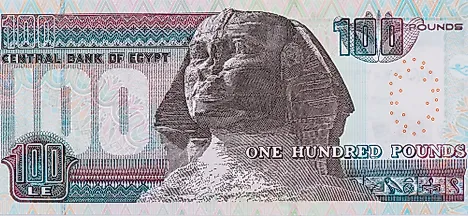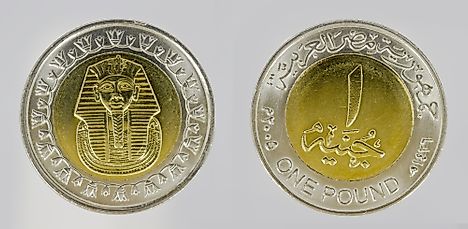Flags, Symbols & Currency of Egypt
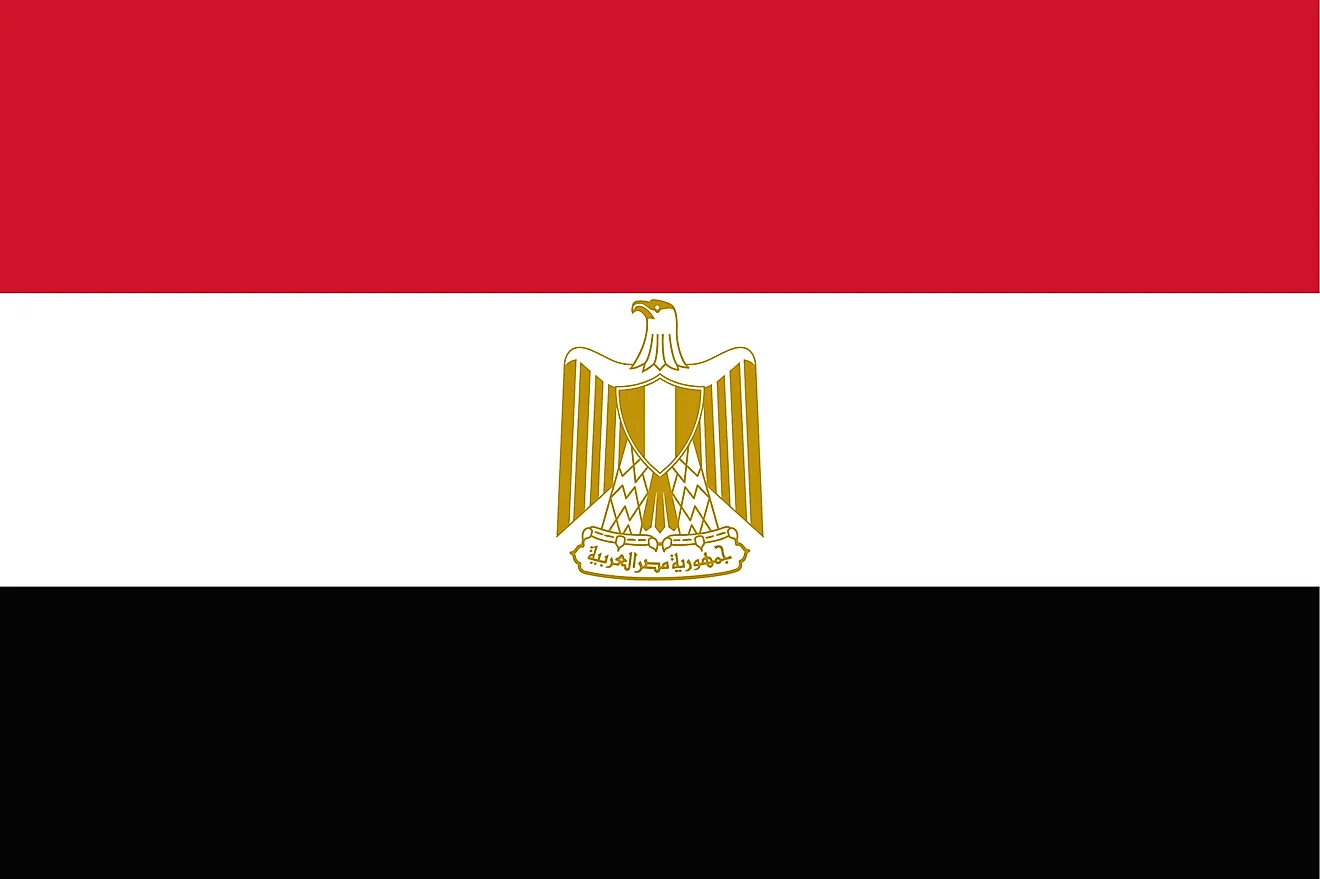
The National Flag of Egypt was officially adopted on October 4, 1984.
The National Flag of Egypt is a horizontal tricolor featuring three equal horizontal bands of red (top), white, and black. The national emblem of Egypt (in gold and white) is centered in the white band. Red, white, and black are the Pan-African colors. The red color represents the sacrifices that the Egyptian people made in their struggle for independence during the British colonization, and later on, in defense of their country in conflicts with the enemies. The white color symbolizes purity as well as the bloodless nature of the 1952 coup that ushered in the Nasser era in Egypt. The black color symbolizes the oppressing period that the Egyptian people were under the autocratic rule of foreigners (the British) and later on the monarchy period. The national emblem of Egypt is the Eagle of Saladin– which is also a symbol of Arab nationalism. The eagle symbolizes the strength, courage, and determination of the Egyptian people. The gold coating of the emblem represents power. The flag has a width-to-length proportion ratio of 2:3.
History of the Flag of Egypt
The Egyptian flag has undergone several transformations before its present state. At first, under the Muhammad Ali Dynasty, it consisted of a single color, red, a crescent shape, and three stars. The design was used until the British began their occupation after the Urabi Revolt in 1882. The cross was added to the crescent and three stars to represent the Christian minority in the country. However, the move was deeply unpopular, and it raised greater nationalist resentment against the British occupiers, subsequently leading to the 1919 Revolution.
Upon independence from the British in 1922, King Fuad I changed the flag color to green and excluded the cross. Green color represented the agricultural activities taking place in Egypt along the Nile as well as in Sudan and Nubia, which were also part of the Kingdom, and was represented by the three stars.
The 1952 Revolution led to the deposing of King Fuad I by the Egyptian free officers. The green background of the flag was replaced with a tricolor of red, white, and black with the eagle of Saladin in the middle. Two green stars eventually replaced the eagle when Egypt and Syria united to form the United Arab Republic in 1958. Abdel Nasser took over in 1958 after toppling King Farouk who had the support of the British. In 1961, Syria eventually withdrew from the United Arab Republic, and the Hawk of Qureish replaced the two stars after Libya joined Egypt in a new Federation of Arab Republics.
In 1977, the Federation of Arab Republics was dissolved, and in 1982, the Eagle of Saladin was restored to the Egyptian flag; and the red band was made darker to make it different from similar flags of Yemen, Iraq, and Syria. Gold was used on the eagle together with white. It has been in use since 1982.
Symbols of Egypt
The National Coat of Arms of Egypt

The current official Coat of Arms of Egypt was adopted in 1984. It features the “Eagle of Saladin” holding onto a golden scroll which bears the name of the country, “Gumhuriyet Miṣr al-ʿArabiyyah” ("Arab Republic of Egypt") in Arabic script. A shield bearing the national flag colors in a vertical configuration is also carried by the eagle on its breast.
National Anthem
- Anthem Title: "Bilādī, laki ḥubbī wa fuʾādī" ("My homeland, you have my love and my heart")
- Music Composer: Sayed Darwish
- Lyricist: Muhammad Yunis al-Qadi
- Date of Adoption: 1979
"Bilādī, laki ḥubbī wa fuʾādī" ("My homeland, you have my love and my heart") is the national anthem of Egypt. The music of the anthem have been composed by Sayed Darwish. The lyrics of the anthem have been authored by Muhammad Yunis al-Qadi. The anthem was officially adopted in 1979.
"Bilādī, laki ḥubbī wa fuʾādī" (Arabic)
كورال:
بلادي بلادي بلادي
لك حبي وفؤادي
بلادي بلادي بلادي
لك حبي وفؤادي
1:
مصر يا أم البلاد
أنت غايتي والمراد
وعلى كل العباد
كم لنيلك من أيادي
كورال:
2:
مصر أنت أغلى درة
فوق جبين الدهر غرة
يا بلادي عيشي حرة
واسلمي رغم الأعادي
كورال:
3:
مصر أولادك كرام
أوفياء يرعوا الزمام
نحن حرب وسلام
وفداكي يا بلادي
كورال:
"My homeland, you have my love and my heart"
Chorus:
My homeland, my homeland, my homeland
You have my love and my heart.
My homeland, my homeland, my homeland
You have my love and my heart.
1:
Egypt! O mother of all countries,
You are my hope and my ambition,
And above all people,
Your Nile has countless graces!
Chorus:
2:
Egypt! Most precious gem,
A blaze on the brow of eternity!
O my homeland, be for ever free,
Safe from every enemy!
Chorus:
3:
Egypt, noble are thy children.
Loyal, and guardians of the reins.
Be we at war or peace
We will sacrifice ourselves for you, my homeland.
Chorus:
The Currency of Egypt is the Egyptian pound
The current official currency of Egypt is the Egyptian pound. One pound is subdivided into 100 piastres or 1,000 millimes. The Egyptian pound is often abbreviated as LE (livre egyptienne) and was introduced in 1834 replacing the Egyptian piastres as the country’s currency. However, piastres continued to be circulated at one-tenth of a pound.
Coins
Silver, copper, and gold coins were in use between 1837 and 1900. The coins were mainly in the denominations of 1, 5, 10, and 20 piastre. One-pound coins were introduced in 1839. In 1885, bronze millieme coins were introduced with gold coins practically ceasing in the same year. Aluminum-bronze coins in the denomination of 1, 5, and 10 millieme were introduced between 1954 and 1956. The size of the silver coin was significantly reduced. The silver coins were abandoned in 1967 and cupro-nickel coins were introduced. The aluminum-bronze coins were replaced by aluminum coins in 1972 followed by brass in 1973.
Banknotes
The National Bank of Egypt introduced the first notes on April 3, 1899, in the denominations of 50 pilasters and 1, 5, 10, 50, and 100 pounds. When the Central Bank of Egypt took over the National Bank of Egypt, it introduced notes in the denominations of 25 piasters and 20 and 200 pounds. The banknotes are all bilingual and characterized by Arabic texts and Arabic-Indic numerals on the observe side and English and Arabic numerals on the reverse. The obverse side also features the Islamic buildings while the reverse features Ancient Egyptian motifs such as statues and inscriptions. In 2011, several banknotes including 25 and 50 piasters and 1 pound were phased out and replaced by the more intensive use of coins. However, the one-pound note was reintroduced into circulation in 2016.
Historical Currencies of Egypt
In 1834, an Egyptian currency based on the Maria Theresa thaler was introduced. The Egyptian pound (geneih) replaced the Egyptian piastre as the chief currency unit. During WWI, the Egyptian pound was pegged to the British pound Sterling. Egypt remained part of the Starling Area until 1962 when Egypt switched to the US dollar at an exchange rate of one Egyptian pound for US$2.3. The Anglo-Egyptian Sudan also used the Egyptian pound as its official currency between 1899 and 1956. Different Egyptian pound values are referred to by their nicknames such as neckla for milliemes, reyal for 20 piastre coins, and sheleh for 5 piasters. However, piasters and milliemes are no longer accepted as legal tender in Egypt. In 1961, The Central Bank of Egypt and The National Bank of Egypt unified and formed The Central Bank of Egypt.

